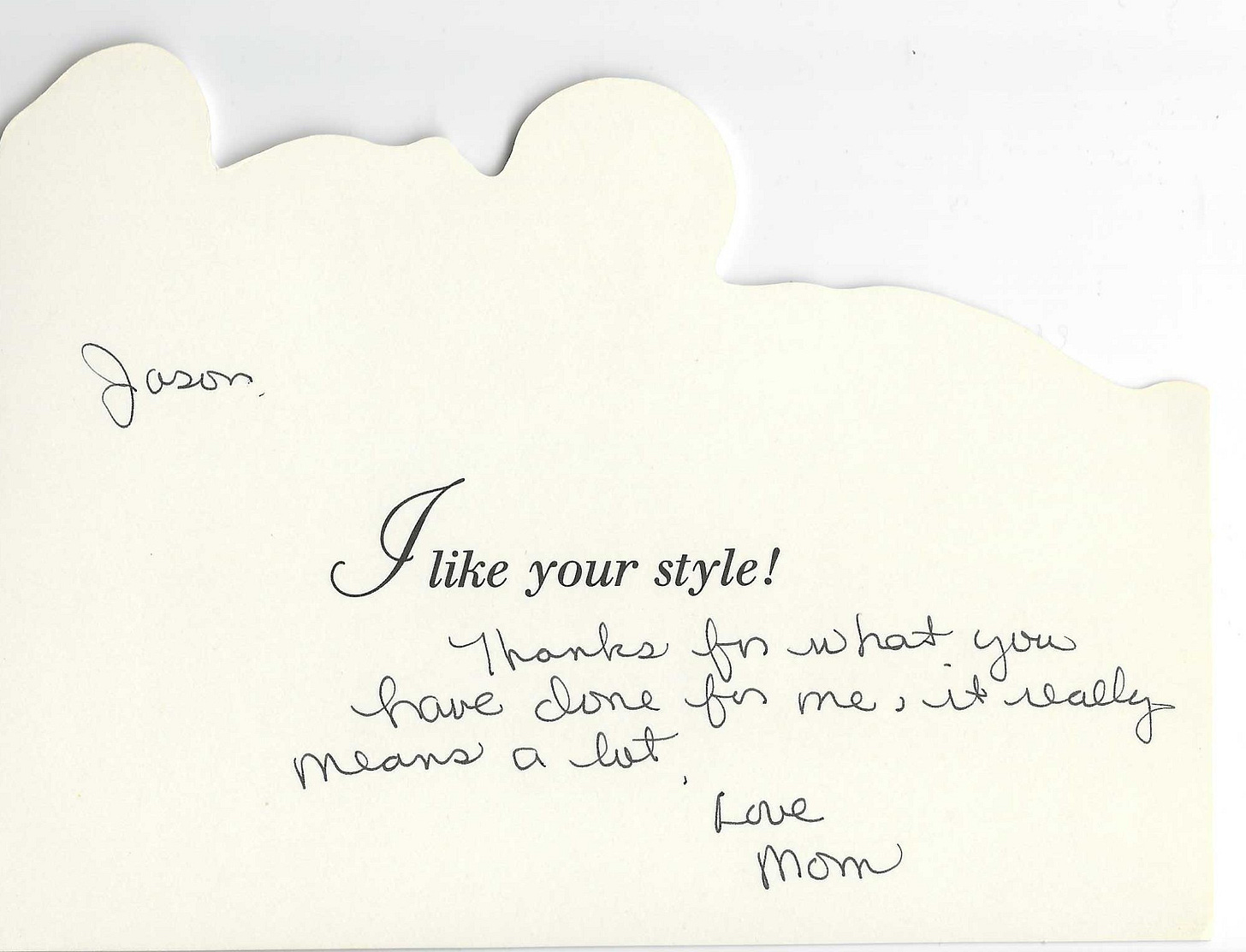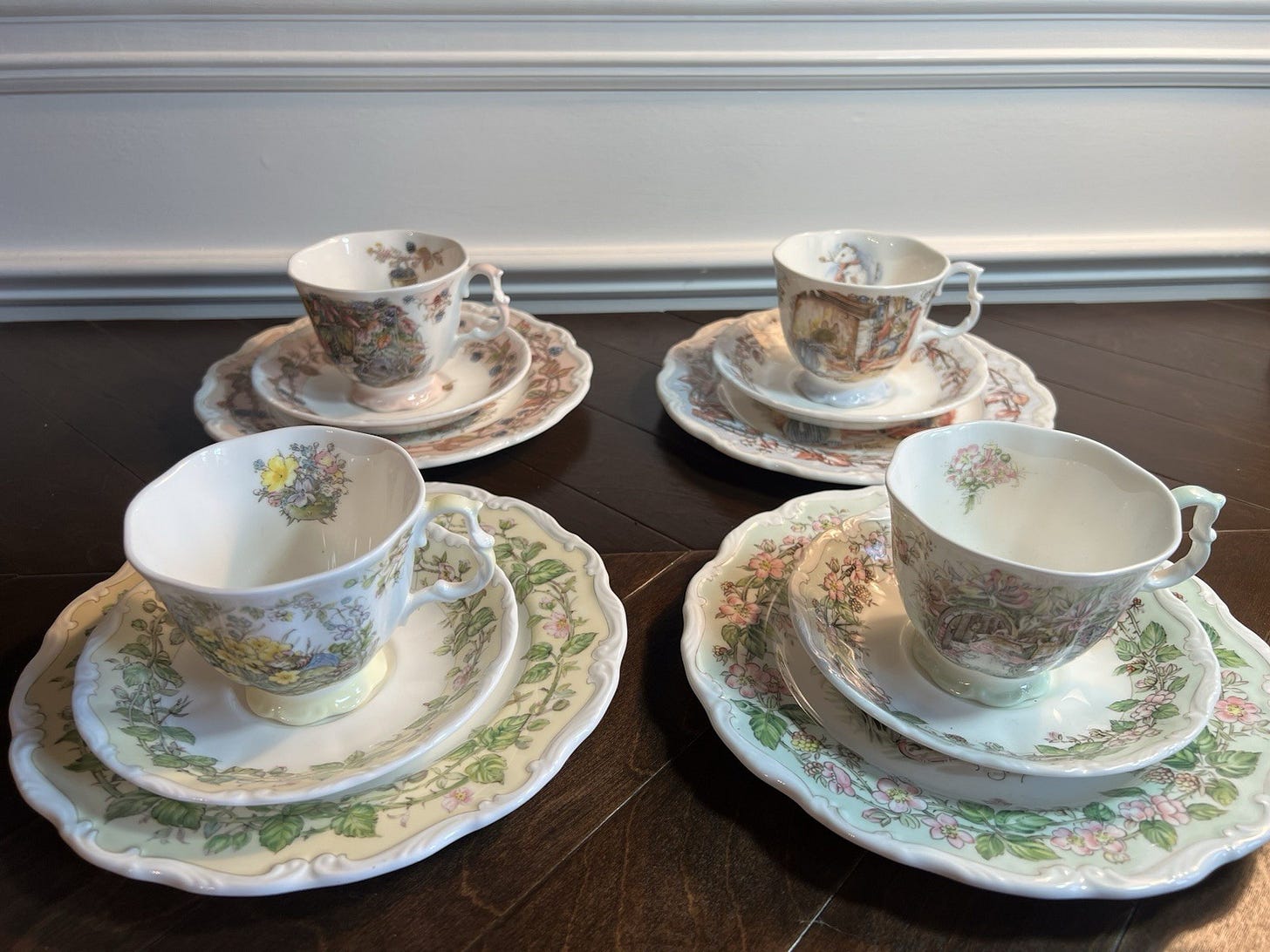Thanks to Alice in Wonderland, in printed and animated form, I was obsessed with tea parties in my early teens. My favorite scene in the book and the Walt Disney movie is the Mad Hatter’s Tea Party. When Lewis Carroll wrote it, everyone knew what a tea party was from first-hand experience. The British ensconced tea as their fourth meal, a nice afternoon break with snacks at four o’clock to tide you over until dinner (which was also later than the American supper). I first learned what a tea party was by inferring its culture from books and movies: tea not coffee, little cakes and sandwiches, dainty china cups and saucers, cloth napkins…tea cozies over elegant pots, silverware, jam and clotted cream. A linen tablecloth. A centerpiece of hand-picked flowers.
I wanted it all. My mom drank coffee, all day, so in that respect she held her own endless coffee party at her usual chair in our kitchen. The only tablecloths we ever used were plastic on picnic tables. We had thick Pfaltzgraf mugs instead of bone china. I yearned after elegant, refined, leisurely lifestyles, and a tea party encapsulated the life I wanted.
But I was an odd teen, I admit. I always loved the Victorian period (I blame the background paintings on Scooby-Doo, loving all iterations of Alice, and my mother’s subscription to Victoria magazine). I bought vintage men’s vests and waistcoats at antique shows. I never wore them in public, but I adored the idea of getting fancy every time you stepped out of your house. I learned about the different phases of architecture in the nineteenth century and identified examples around town. Queen Anne mansions were (and are still) my favorite followed closely by carpenter Gothic. Grand houses, antiques, and finery suggested a way of living that was the complete opposite of mine.
Once my friend Molly (who happened to live in an amazing carpenter Gothic house, lucky bitch) asked me what time period I would travel back to, and I answered, “The Victorian age.”
She grimaced. “But that wasn’t a very good time for women.”
“Oh, I meant stylistically, not politically,” I stammered. “I like the houses and furniture and clothes, but yeah not a great time to be female or poor.” Not an ideal time to be gay, either, as demonstrated by Oscar Wilde’s case.
My longing to have a tea party popped up long after I passed the age of pretend tea parties with my stuffed animals, unfortunately. That held no appeal. I wanted the real thing.
I earned a few bucks a week babysitting the three kids from two houses over. My little brother Jacob was the same age as their oldest daughter Crystal. I kid you not, her sister’s name was Tiffany (followed by Jennifer if you hadn’t already guessed). One summer afternoon, I decided to manifest my dream with a mix of real live human guests and plush animals. I took one of my grandmother’s old plaid wool blankets and spread it in the shade of our lilac grove. I brewed Lipton tea in a saucepan and poured it into a Tupperware pitcher. Our Pfaltzgraf set of blue and white stoneware would have to substitute for proper place settings. I gathered shortbread cookies I had found in the cupboard, Smuckers strawberry jam, and the tub of margarine, and brought them all down to the picnic blanket.
“What are you doing with my plates?” my mother asked. The frequent slam of the back storm door roused her from her sewing.
“We’re having a tea party,” I said. “I need the cups and saucers too.”
She humpfed. “Well, don’t break any.” She went back to her cigarette and teddy bear stuffing.
When it was time to babysit the kids, Jacob and I went over to their house. I told the kids to bring their favorite stuffed animal out to the yard. “We’re going to have a tea party!”
“What’s that?” Crystal asked.
“I’ll show you!” The kids trooped down to the lilac grove with their stuffies, and we sat down to the feast. It was…not what I had pictured. The girls had no interest in tea or daubing jam onto their shortbread. I coaxed them to pretend their stuffed animals were indulging in a cuppa, but no, they wanted to revert back to hide and seek or riding their stupid little tricycles. After a few minutes, I gave up and started the disappointing clean-up process.
It was neither elegant nor refined. No conversation sparkled. No one lifted their pinky to drink, not even me, I was so discouraged.
I had another chance a year later. My mother told me that no one had thrown her a birthday party in years. I thought back to her birthday observances and realized she was right. Her birthday is merely four days after her older sister’s. We celebrated the occasions as a joint party, as if they were twins, in Aunt Nancy’s backyard. My father was not the sort to think about sweet things like making his wife feel special—or maybe he did think about it but never acted on it.
“I’ll throw you a birthday tea party this year,” I offered. She looked quizzical. “Here?”
“Yeah, right here,” I said with a look around our eat-in kitchen. A birthday tea party was what I always wanted, so why would she not want it? I knew from my failed picnic that we had enough plates, mugs, and saucers to host a decent-sized group. Never mind that our house did not have potted palms, a silver tea set, or air conditioning. I didn’t care who the guests were (obviously) and I liked eavesdropping on adults’ chats. I was used to listening, absorbing housewife-y information and gossip, and staying silent. This was my first real chance to throw a very grown-up event!
I forget what I served—except I do recall a fruit-topped cheesecake, at my mother’s request. I used a store-bought graham cracker crust and “exotic” fruit like kiwi. I remember this because one of Mommy’s friends, Chris, ordered one from me a few weeks later. My first (and last?) catering job. Surely the guests dined on cucumber sandwiches since they were one of my mother’s favorite summer treats. And actual tea? Gourmet or specialty teas were not in vogue at the time except for Celestial Seasonings, so perhaps I brewed a few bags of those. Mommy’s circle was into coffee, like her.
What I do remember: I made my mother clear off the dining table (a lengthy process), had my dad put in the leaf to extend it, and threw an antique quilt over it as a tablecloth. I did place settings as best I could with the Pfaltzgraf, and lamented that we did not have any cloth napkins or napkin rings. We composed a bouquet from flowers and snips of greenery from our yard and put it in the center of the table in a glass water pitcher. Our eat-in kitchen never looked better.
Mommy’s friends arrived, and each one stopped in the kitchen doorway in surprise. Our house never looked that formal, as ramshackle as it turned out. Some of them oohed and aahhed. We supplemented our four massive colonial wood chairs with a few metal folded ones, and guests took whichever seat they liked. Because I was a rookie who did not double check the RSVP list against my mental seating chart, a few late arrivals had to sit in the corners and balance plates on their knees. Fortunately, these women did not complain.
I brought plates of food over from the stove, acting as waiter and event planner, and took in their conversation. I got compliments on my culinary creations. They did not drink much tea at all, but at least they had a good time. I enjoyed hosting quietly from the stove. We did the usual present exchange, then Mommy’s friends trickled out. I returned to the table to start cleaning up, and there was one more wrapped gift and card near the bouquet.
“You forgot one!” I announced.
“That’s for you,” my mother said.
“Me? Why? It’s your birthday.” I sat down. Mommy handed me the envelope. I slid my finger under the flap and pulled out a die cut card with a photo of a teddy bear. It was an image from Ophelia’s World, a book she bought but I loved it so much I kept it under my bed. I opened the card.
I blushed at this expression of gratitude and love. The words she added to the card’s text, though short, made me feel grown up.
Mommy plunked the gift box in my lap. I gingerly opened the thick, shiny, cream-colored paper. Inside, I found a bone china teacup, saucer, plate, and book gift set from Royal Doulton’s Brambly Hedge line. I knew the china manufacturer from reading magazines. While my mother fell for bears and dolls, I was obsessed with mice. This set included the picture book for Autumn, and the china’s design used the same artwork.
“There are three more gift sets, for the other seasons,” my mother explained. “Someday you can collect the whole set.”
“Thank you,” I said quietly. My mother must have spent more money on this surprise for me than the entire tea party, and then some. Her gift giving skills were on point: the china set combined all of my interests, including my favorite season.
I put the cup and plate back in their protective box after admiring the smoothness of the enamel and the way the bone china felt under my fingertip. I held the saucer up to the sunny window. Yes, I could see shadows through it. It was real china.
I was embarrassed and humbled by this perfect gift. I felt as if I did not deserve it, both for its cost and its meaning. I had not set out to throw a party just to be noticed, or to get a gift in return. I did it because I wanted to. If throwing a tea party for your mother makes you a momma’s boy, then that’s what I was.
Our family does not express emotions with words or physical affection. We communicate in other ways, like the effort to gather friends and celebrate in style. My mother expressed herself through gift giving—ideally with handmade presents or baked goods, but she had a knack for finding just the right gift in a store too.
A few Christmases later, Mommy gifted me the entire set: the three remaining seasonal place settings, the teapot, creamer, sugar bowl, canape tray, and more. By the time I had it all, however, I was older and not so into mice any more. I was less interested in fancy tea parties and more into goth music and ogling the male seniors in gym class. She told me she bartered with one of her customers to grab the whole line of Royal Doulton pieces at once.
I wish I could say I used all four place settings and the tea service at a truly spectacular party…but I can’t. I never had the chance to put it all out. I kept them all in their original boxes under my bed for years, and rescued them from the pole barn when my mother abandoned the house. When I needed money in my twenties, I sold them as one lot on eBay to an appreciative buyer for far less than what a complete set sells for now. Though I sold the china, I still have the card tucked into the pages of Ophelia’s World.
Happy belated birthday Aunt Nancy, and happy birthday to my mother, who would have turned 71 today.







